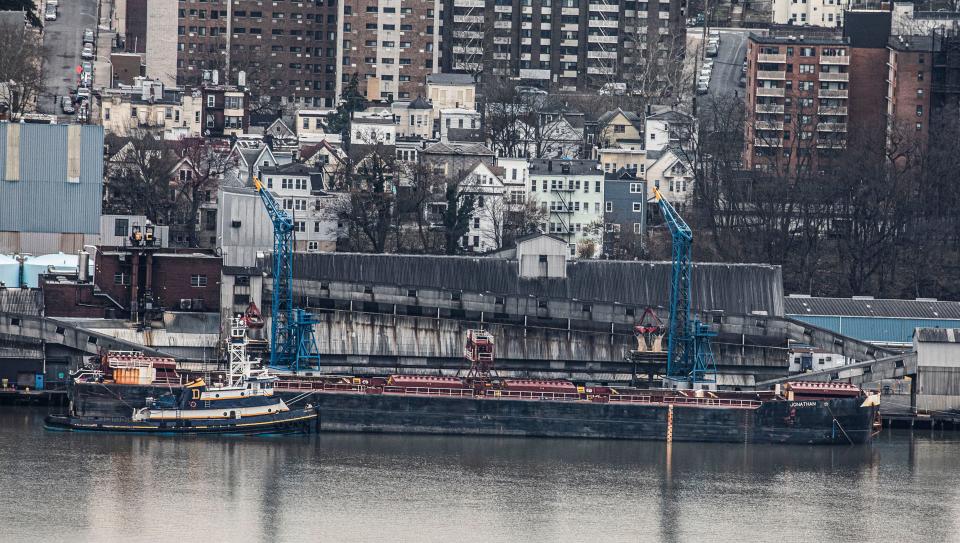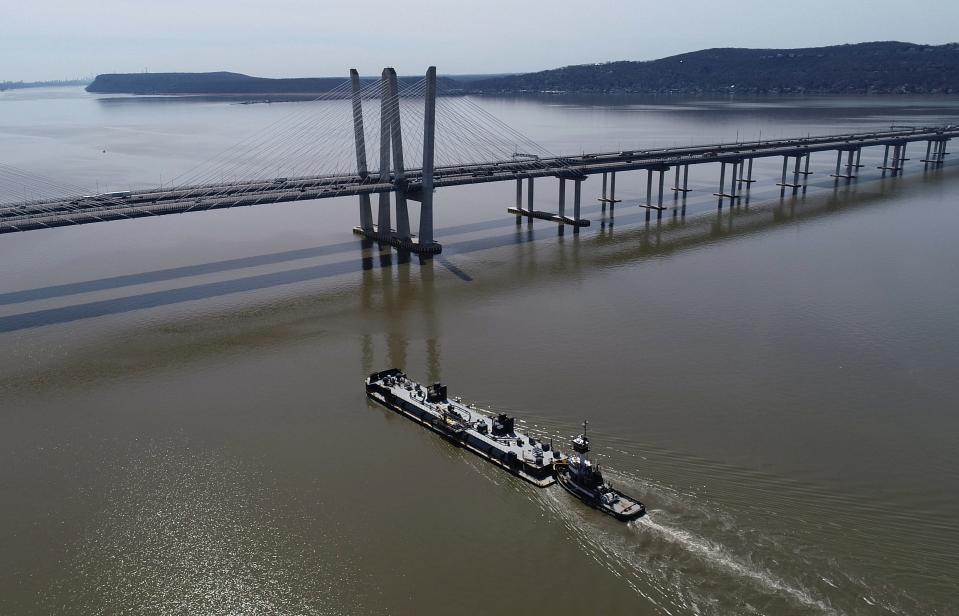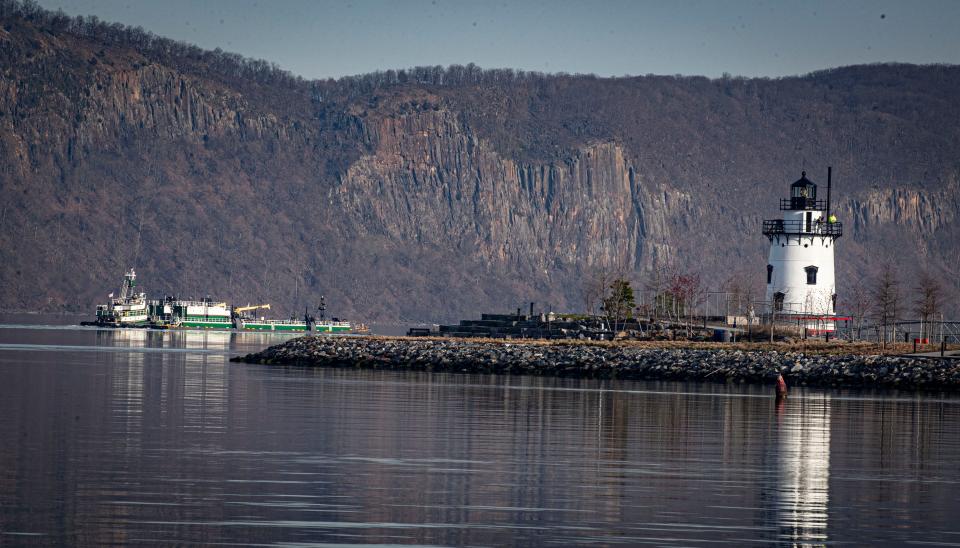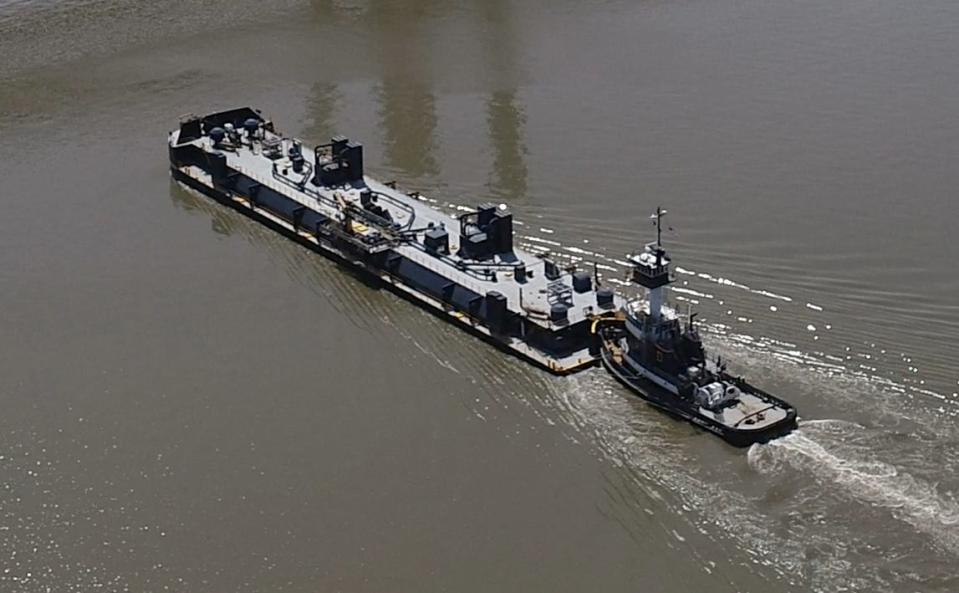Quietly, the Hudson River is still used to transport key cargo. Can it take on more?
On an average day, much of the Hudson River is calm, interrupted in spots by the clattering of passing trains. But on the shoreline at Buchanan, where the now-shuttered Indian Point is located, there is regular activity. Not long ago, a 650-foot-long ship was tied up at a dock at the CertainTeed wallboard factory, unloading a cargo of gypsum mined in Spain.
The product was scooped out of the hold by the ship's own cranes and dumped in a hopper on the shore. From there it was fed onto a covered conveyor belt that trundles up a steep slope, depositing the material in an open shed adjoining the sprawling factory building. The plant gets a delivery like this about once a month and if you are reading this within 100 miles of Buchanan, there is a good chance that the walls around you were made there.
Plant manager Paul Woolweaver is clearly proud of the capacity and efficiency of his operation, which occupies nearly 40 acres of waterfront property, runs 24/7, and produces enough wallboard to build 250 homes per day. He knows he is dependent on the river access that allows him to bring in his primary raw material. “If I didn’t have river access, we couldn’t operate. There’s just no way that it would be profitable or sustainable,” he says.
The Dutch recognized the value of this waterway, which they called the North River, when they established their New Netherland colony 400 years ago this year, in 1624. The enterprise was anchored by trading posts on Governors Island in New York Harbor and Fort Orange, near present day Albany. Four centuries later, planners and policymakers are looking for new ways to grow the regional economy and bring jobs back from overseas without further overtaxing the congested highway system or jeopardizing climate goals.

The Hudson River offers a low maintenance "marine highway" for moving materials quickly and cleanly between the East Coast’s busiest seaport and the interior of the state, an intriguing resource as policymakers try to solve this equation. Some companies have figured out new ways to benefit from this highway in the 21st century.
But realizing the river's full potential is complicated by land use decisions made over decades, the containerized nature of the distribution system for goods, and by the concerns of environmentalists and others about keeping the river clean and accessible to the public. The recent accident in Baltimore also provides a reminder that marine transportation is not without risks, though no ships as large as the Dali cargo ship travel up the Hudson.
The marine highway continues for some
About 20 miles south of Buchanan, ASR Group’s Domino Sugar refinery in Yonkers is another beneficiary of river access. Barges and ships arrive there about 40 times per year carrying raw sugar, mostly from farms in Florida, but sometimes from the Caribbean or South America. “This is a maritime dependent industry,” says Peter O’Malley, vice president for corporate relations at ASR Group, pointing out that all of ASR’s plants are located where they have water access. “It’s just not feasible to get that much sugar by train or truck to refineries,” he says.
The refinery receives about 40 deliveries by ship or barge per year and processes 4.2 million pounds of sugar per day. If you live in the Northeast and have a familiar yellow and white bag of Domino Sugar, it probably came from this plant.
Manufacturing businesses lined the Hudson River in Westchester for most of the 19th and 20th centuries, but high costs, crowded roads and rising residential real estate prices have seen most industrial activity decamp. As the region has deindustrialized, the public has gained access to the water to an extent that would once have been unimaginable. Vibrant parks now flourish in areas once roped off by industrial users.
But the Domino and CertainTeed plants persist, producing products for nearby customers and providing over 500 jobs combined, most of them union positions. Both companies deliver their finished product to customers by truck. But both serve the regional market, so operating factories in Westchester means fewer truck miles to get sugar on shelves and wallboard to worksites than if it all had to be brought in from the Midwest or the South.
Many New Yorkers do not realize how much cargo moves along the river today. In addition to gypsum and sugar, on any given day you might find ships and barges carrying refined petroleum products, wood pulp, road salt, cement, molasses, wheat, scrap metal, sand, oversized machinery, or stone.
Army Corps of Engineers data shows about 13 million tons of cargo moving on the Hudson annually between New York City and just north of Albany. Still, this is only a fraction of the total volume that is moving on roads. According to New York State’s Department of Transportation, 84% of freight tonnage in the state moves by truck and only 8% by water, and that includes freight moving on waters around New York City, Long Island, and the Great Lakes.
There is room on the river for more ships and barges. Even groups focused on preserving the beauty and cleanliness of the Hudson do not object to more shipping. “The Hudson has a long history as a commercial corridor,” says Ned Sullivan, president of Scenic Hudson.

The group and others do worry about the petrochemical barges that ply the river regularly. Environmental and civic groups and public officials have fought against proposals that would allow more vessels to anchor on the river, a topic of recurring tension with the marine industry. But, Sullivan says, “we’re not afraid of more traffic.”
The real constraint on increasing shipping on the river is actually on land. Finding new locations to load and receive cargo is not easy. Prospective users must contend with high real estate prices, lengthy environmental review processes, and community pressure to open up more access for recreational use. There has been a wallboard factory in Buchanan since the 1960s, and the Yonkers sugar refinery dates back to the 1920s. Finding new locations for operations like these would be a major challenge.
Finding new on-ramps to the Hudson
Old industrial cities with deep water access along the river seem to have little interest in going back to their manufacturing roots. In Poughkeepsie, the debate over the future of the city’s last remaining waterfront brownfield site has revolved around the appropriate mix of commercial, office, hotel, and residential spaces, as well as public access for recreation, according to Kafui Attoh, an associate professor at CUNY School of Labor and Urban Studies, who served on a task force reviewing plans for the site. Until 1990, the site housed the DeLaval milk separator plant, at one time one of Poughkeepsie’s largest employers. But the idea of returning manufacturing to the waterfront has no traction today. “It’s not something that was brought up,” says Atoh. “It wasn’t even a topic.”
Still, some companies have managed to find new ways to access the water in the 21st century, utilizing the footprint of older industrial sites, primarily along the northern reaches of the navigable river and in locations somewhat removed from population centers.

Innovative Surface Solutions, a producer of de-icing chemicals, bought a defunct Texaco oil products terminal in Glenmont, south of Albany, a little over 10 years ago and converted it into a facility to manufacture their product. The plant takes regular deliveries of its primary raw material, magnesium chloride, by tanker. The Canadian-based company’s head of marketing Anne-Marie Short says year-round access to the river is vital for the company, which employs about 30 workers on site and loses water access to its Canadian plant in the winter due to ice.
A bit to the south, in Cementon, a hamlet in the Town of Catskill, a pier at an unused cement plant was upgraded several years ago to accommodate ocean going bulk ships, allowing imported cement to be brought in for delivery to nearby customers.
The publicly-owned Port of Albany also has been exploring ways to reuse existing space and expand. In 2018, the port purchased a large parcel of land to its south in the Town of Bethlehem that had been covered with coal ash dumped by a neighboring power plant. The site is being remediated and the plan is for it to become a manufacturing facility for offshore wind turbines. Port of Albany says this is the first fully permitted turbine factory in the Northeast, and the port is moving ahead with preparing the site, despite questions about funding. The port’s permit will limit the facility to 100 towers per year initially, a stipulation that regulators requested out of concern about how more shipping could affect the endangered shad population.
The Port of Albany also houses a historic grain elevator, the largest east of the Mississippi. Formerly used to hold grain for exports, which ended in 2018, the elevator has now been converted to receive imported wheat by one of the port’s tenants, Ardent Mills. Polish wheat began arriving by ship in 2023, a new cargo for the Hudson River.
A bit south of Albany, in the Town of Coeymans (pronounced “Kwee Mans”), the Carver construction and materials company built a new port on the location of an old brick factory in 2008. The private port now handles stone and mineral cargos delivered by the company's own fleet of tugs and barges, and can receive large bulk ships from overseas as well. The port is also gearing up to host wind turbine assembly operations.
While the list is not long, the economics of moving heavy cargo have clearly led some companies to find a way to get on the water.
Is there a future for consumer goods moving on the river?
One common denominator of the varied cargos that move on the river today is that they are either bulk products or oversized machinery that can’t easily move by road or rail. Offshore wind turbines will also fall into this category. Consumer-sized items are entirely absent from the mix.

Even stalwart river users with their own docking facilities like Domino, CertainTeed, and Innovative Surface Solutions deliver their final products to customers by truck. To really make a dent in the steady stream of truck traffic moving through New York State, the river would need to begin carrying consumer goods as well.
“There’s no more efficient way to move anything from A to B than on the water. And you should do that for as much of that thing’s trip as possible,” says John Callaghan, who served for nearly two decades as head of the New York State Canal Corporation and started his working life tending buoys along the river for the Coast Guard. “So much of what ends up on our doorstep in an Amazon package has taken a water journey already, but was probably put on a truck too early in some cases.”
Consumer goods in the modern era generally move long distances in standardized shipping containers. Containers can easily be transferred between ships, trucks, and trains, but require space and heavy equipment for unloading. Currently, containerized goods coming to our region from overseas arrive on huge ships in New York Harbor or other major sea ports and are transferred to trucks or trains for the remainder of their journey.
The big container ships that call on the Port of New York and New Jersey, and Baltimore, are too large to travel up the river. But a container barge service operated on the Hudson briefly between 2005 and 2007, ferrying boxes unloaded in New York Harbor up to Albany. The containers were packed with goods, like crates of olive oil from Italy, heading for a local retailer that would otherwise have come north from New Jersey by truck.
The service faltered mainly due to congestion issues at the container docks in New York Harbor and because an absence of cargo moving south made it uneconomical, even with a subsidy from New York State, according to Richard Hendrick, CEO of the Port of Albany. But when operated at full capacity, two weekly round trips combined were capable of taking 1,000 trucks off the road per week, a small but not insignificant fraction of the 5,000 to 20,000 trucks the state Department of Transportation estimates run up and down Interstate 87 daily.
Increasing barge traffic still a goal
The Port of Albany wants to revive the service, but the economics of moving containers north on the river are not as clear cut as they are for bulk material and liquids. Hendrick says that back in 2019 he had been talking with some manufacturers upstate about moving their export-bound containers from trucks heading for New York Harbor to barges. This would have resulted in fewer containers heading south empty, improving the economic proposition of the service, but COVID interrupted those talks and the discussions lost momentum.
Getting the service going again would likely require some subsidy from the government, according to Hendrick, and coordinating among different state agencies in New York and New Jersey is always a challenge.
On the other end of the highway, the Port Authority of New York and New Jersey says they also are keen to see more container barge operations, not just to Albany but also to ports elsewhere in the northeast. But, while the Port Authority sees a role for public grants to cover start-up costs and equipment, the goal is to identify routes that can run on their own economic merits, without ongoing subsidy. “If that subsidy goes away, then the service would have to go away too,” says Blair Wegescheide, the Port Authority's manager of port efficiency.
As with many responses to the climate crisis, seemingly compelling approaches are complicated to implement. There are costs associated with traffic and truck pollution, but private companies do not get any direct reward for reducing these costs. Similarly, the public can readily appreciate the recreational and aesthetic benefits of access to the river but is largely unaware of the costs of lost maritime capacity, which often fall on less affluent communities far from the water.
Most home builders and bakers are completely unaware that the wallboard and sugar they rely on was produced nearby thanks to marine transportation.
But pressure to reduce reliance on fossil fuels and a highway system that is at capacity are realities that are not going away. As the public and private sectors look for alternatives, it seems reasonable to expect continuing rediscovery of what the Dutch understood four centuries ago.
This article originally appeared on Rockland/Westchester Journal News: Hudson River in NY could transport more goods if port plans proceed

